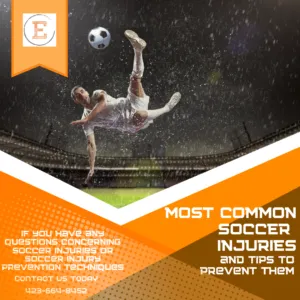“The rules of soccer are very simple, basically it is this: if it moves, kick it. If it doesn’t move, kick it until it does.” –Phil Abraham
Knee injuries are some of the most frequent ones in soccer. This is due to the fact that soccer is a game in which players must halt abruptly and change their course.
The ligaments that support the knees and the knees themselves are subjected to significant rotational stress during explosive, spontaneous movement. A ligament can sprain or tear in the knee joint when the load is too much for it.
Most common soccer injuries
1. Knee ligament injuries
- Ligaments bind bones together. The Femur and Tibia are connected by four ligaments in the knee:
-Anterior cruciate ligament (ACL)
-Posterior cruciate ligament (PCL)
-Medial collateral ligament (MCL)
-Lateral collateral ligament (LCL) - Damage to any of these ligaments prevent athletes from making a proper knee bend, inability to run, and pain with cutting.
- Running and abruptly changing directions or receiving direct hits to the knees can injure knee ligaments.
2. Ankle Sprains
- When the ligaments encircling the ankle joint are stretched and torn, an ankle sprain results.
- Soccer players who kick the ball with the top of their foot risk lateral ankle sprains (outside of the ankle). When the foot is flexed up while the toes are turned out, a medial ankle sprain (inside of the ankle) might happen.
3. Achilles Tendon Rupture
- In a rupture, the Achilles tendon is partially or completely torn, frequently accompanied by an audible popping sound.
- This can happen when a soccer player makes quick, explosive movements, like sprinting after the ball or swerving away from a player from the opposing team.
4. Concussion
- Concussion is a type of mild traumatic brain injury (mTBI) brought on by a sudden blow to the head.
- Concussions can also result from collisions with the ground or other players.
5. Groin Pull
- When the muscles in the inner thigh are stretched past their breaking point, a groin pull is one sort of strain that results.
- When kicking the ball or coming up against resistance from an opponent trying to kick the ball in a different direction, a soccer player may tear their groin muscle.
6. Hamstring Injury
- Hamstring injuries can range from a moderate strain to a complete rupture and affect the three back muscles of the thigh.
- In soccer, the constant stopping, sprinting, and running movements can cause hamstring injury.
7. Plantar Fasciitis
- This frequent source of foot discomfort is brought on by inflammation of the connective band that connects the heel to the toes.
- Soccer players may develop plantar fasciitis for a variety of reasons, including playing on hard surfaces or wearing improper footwear with inadequate arch support.
8. Shin Splints
- Shin splints are a collective term for a number of uncomfortable symptoms that appear in the front of the lower thigh, frequently following an increase in or modification of exercise.
- Some soccer players may get shin splints from practicing without the proper cleats.
How can injuries be prevented?
- Before the game, warm up for at least 30 minutes.
- Put on safety gear
- Cross-train
- Cardio: To get your heart rate up, start out with a few laps
- Start with short-distance passing and ultimately progress to longer drives.
- Shooting: Increase your difficulty by starting with lighter, shorter shots on net.
- Sprinting: Incorporate a couple brief sprints.
- If you have any questions concerning football injuries or football injury prevention techniques, get in touch with Elite Muscle Recovery.
If you have any questions concerning soccer injuries or soccer injury prevention techniques you can give us a call so that we can help you please contact us and we will get back to you as soon as possible visit our website at: https://elite-musclerecovery.com/
please call us: 📞423-664-8452



